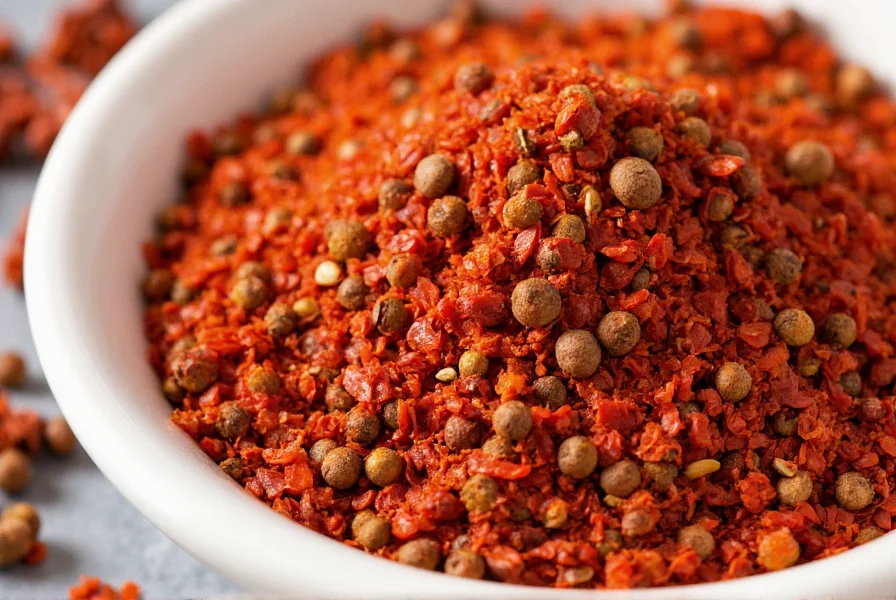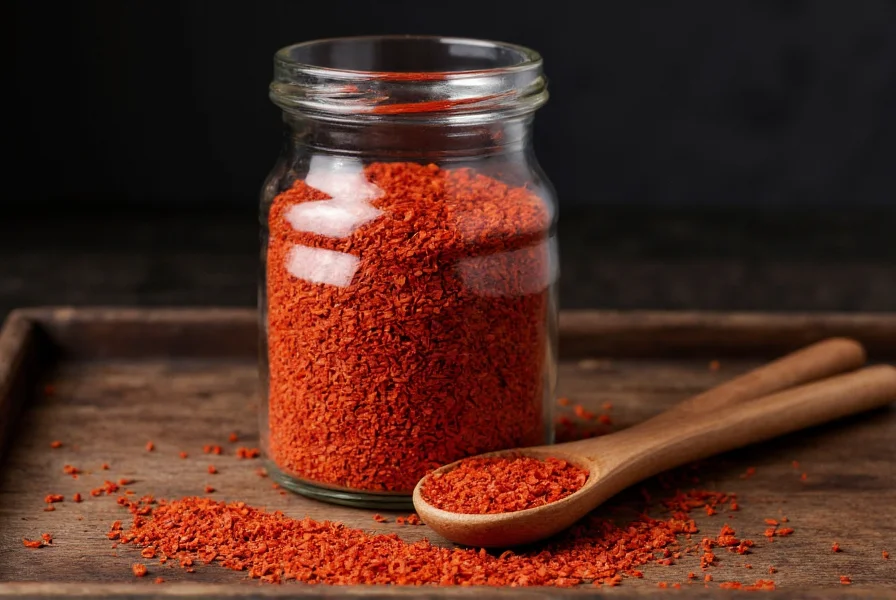Sichuan chili flakes represent one of China's most distinctive culinary innovations, offering a complex flavor experience that goes far beyond simple heat. These vibrant red flakes originate from China's Sichuan province, where chefs have perfected the art of balancing fiery spice with the unique tingling sensation known as ma la. Understanding this specialty ingredient unlocks authentic flavors in countless Asian dishes.
What Makes Authentic Sichuan Chili Flakes Unique
The magic of genuine Sichuan chili flakes lies in their carefully curated blend of ingredients. Unlike standard chili flakes found in Western pantries, authentic Sichuan varieties typically combine two key components:
- Dried facing heaven chilies (or similar regional varieties) for moderate heat
- Coarsely ground Sichuan peppercorns that deliver the signature numbing sensation
This dual-component approach creates the celebrated ma la effect—"ma" referring to the tingling numbness from Sichuan peppercorns and "la" representing the spicy heat from the chilies. The precise ratio varies by producer, with traditional recipes maintaining approximately 70% chilies to 30% peppercorns for balanced flavor.
| Characteristic | Sichuan Chili Flakes | Regular Chili Flakes |
|---|---|---|
| Primary Ingredients | Chilies + Sichuan peppercorns | Chilies only |
| Heat Level (SHU) | Moderate (5,000-15,000) | Variable (0-50,000+) |
| Signature Sensation | Numbing-spicy (ma la) | Direct heat only |
| Color | Vibrant crimson red | Bright red to dark burgundy |
| Common Culinary Use | Sichuan hot pot, mapo tofu, dan dan noodles | General spice enhancement |
Flavor Profile and Sensory Experience
Sichuan chili flakes deliver a multi-stage flavor journey that distinguishes them from ordinary chili products. When properly used, they provide:
- Initial aroma: A complex fragrance with floral notes from the Sichuan peppercorns
- First taste: Moderate heat building gradually (unlike the immediate punch of cayenne)
- Middle phase: Tingling sensation spreading across the tongue and lips
- Finish: Lingering warmth with subtle citrus undertones from quality peppercorns
The heat level typically registers between 5,000-15,000 Scoville Heat Units—significantly milder than cayenne (30,000-50,000 SHU) but more intense than paprika (500-1,000 SHU). This moderate heat allows the distinctive numbing quality to shine through without overwhelming the palate.

Traditional Production Methods
Authentic Sichuan chili flakes follow time-honored preparation techniques that impact their final quality:
- Chili selection: Typically uses facing heaven chilies (朝天椒) or er jing tiao varieties grown in Sichuan's humid climate
- Drying process: Sun-dried naturally until brittle, preserving flavor compounds
- Processing: Hand-crushed rather than machine-ground to maintain texture
- Blending: Mixed with toasted Sichuan peppercorns at precise ratios
The most premium varieties undergo additional steps like dry-frying the chilies before crushing, which enhances their natural sweetness and deepens the red color. This careful processing explains why authentic Sichuan chili flakes command higher prices than generic alternatives.
Proper Culinary Applications
Understanding how to use Sichuan chili flakes properly makes the difference between authentic flavor and disappointing results. For best results:
- Oil infusion: Heat flakes in oil first to release flavors before adding other ingredients
- Temperature control: Avoid high heat that burns the delicate peppercorns
- Timing: Add early in cooking for infused heat, later for brighter flavor
- Quantity: Start with 1-2 teaspoons per serving and adjust to preference
Traditional Sichuan dishes that showcase this ingredient include:
- Mapo tofu (spicy tofu with minced meat)
- Dan dan noodles (noodles with spicy sauce)
- Sichuan hot pot dipping sauces
- Twice-cooked pork
- Spicy wontons
Storage and Shelf Life Considerations
To maintain the vibrant flavor and color of Sichuan chili flakes:
- Store in airtight containers away from light and moisture
- Keep in a cool, dark place (not the refrigerator, which introduces moisture)
- Use within 6-8 months for peak flavor (the numbing quality diminishes over time)
- Check for color fading, which indicates loss of potency
Properly stored Sichuan chili flakes should retain their characteristic crimson hue. If the color turns dark brown or the flakes feel damp, the product has likely degraded and won't deliver authentic flavor.

Common Substitutions and Limitations
When authentic Sichuan chili flakes aren't available, consider these alternatives with important caveats:
- Regular chili flakes + Sichuan peppercorns: Use 2 parts chili flakes to 1 part coarsely ground Sichuan peppercorns (closest approximation)
- Chili crisp: Provides similar heat but lacks the dry texture and may contain additional ingredients
- Crushed red pepper +花椒 oil: Creates similar sensation but with different texture and oil-based delivery
Important note: Standard chili powder or crushed red pepper alone cannot replicate the signature ma la effect, as they lack the essential Sichuan peppercorn component. For authentic Sichuan dishes, the complete flavor profile matters more than just heat level.
Frequently Asked Questions
What's the difference between Sichuan chili flakes and regular chili flakes?
Authentic Sichuan chili flakes contain both dried chilies and coarsely ground Sichuan peppercorns, creating the signature 'ma la' (numbing-spicy) sensation. Regular chili flakes contain only chilies, delivering straightforward heat without the distinctive tingling numbness. Sichuan varieties also typically use specific chili types like facing heaven chilies that provide moderate heat with complex flavor notes.
How spicy are genuine Sichuan chili flakes compared to other peppers?
Authentic Sichuan chili flakes register between 5,000-15,000 Scoville Heat Units, making them milder than cayenne pepper (30,000-50,000 SHU) but spicier than paprika (500-1,000 SHU). The heat builds gradually rather than hitting immediately, and the numbing sensation from Sichuan peppercorns actually tempers the perceived heat level, creating a more complex experience than straightforward spiciness.
Can I substitute regular chili flakes for Sichuan chili flakes in recipes?
While you can substitute regular chili flakes for heat, you'll miss the essential 'ma la' (numbing-spicy) experience central to authentic Sichuan cuisine. For closer approximation, combine 2 parts regular chili flakes with 1 part coarsely ground toasted Sichuan peppercorns. However, dishes like mapo tofu or dan dan noodles won't achieve their characteristic flavor profile without the proper balance of both components found in genuine Sichuan chili flakes.
How should I store Sichuan chili flakes to maintain freshness?
Store Sichuan chili flakes in an airtight container away from light, heat, and moisture. Keep them in a cool, dark cupboard (not the refrigerator, which introduces humidity). Properly stored, they maintain peak flavor for 6-8 months. Check for vibrant crimson color—fading to brown indicates loss of potency. The numbing quality from Sichuan peppercorns diminishes faster than the heat, so fresher product delivers the complete authentic experience.
Why do some Sichuan chili flakes have different colors?
Color variation in Sichuan chili flakes indicates different chili varieties and processing methods. Vibrant crimson red suggests high-quality facing heaven chilies that were properly sun-dried. Darker red or brownish hues may indicate over-drying, lower quality chilies, or excessive heat during processing. Premium varieties maintain bright color because producers carefully control the drying and toasting process to preserve flavor compounds and visual appeal, which directly correlates with flavor quality.











 浙公网安备
33010002000092号
浙公网安备
33010002000092号 浙B2-20120091-4
浙B2-20120091-4